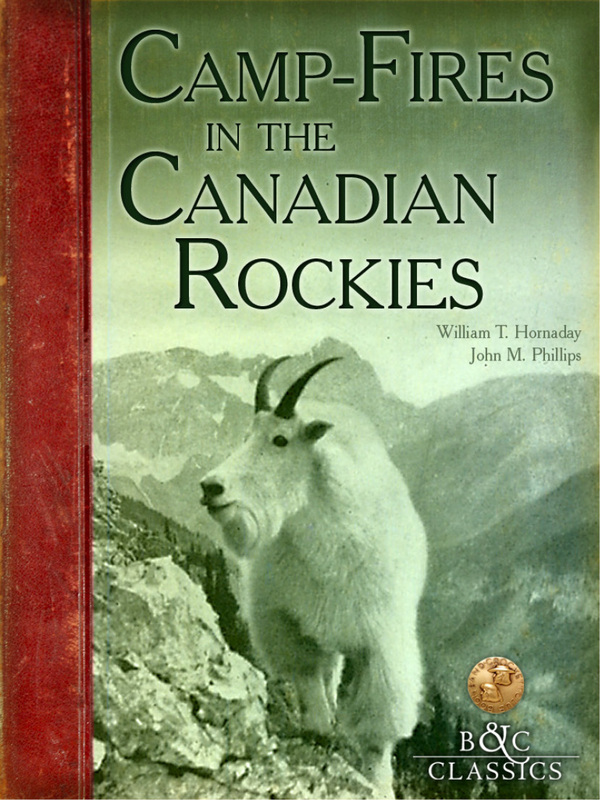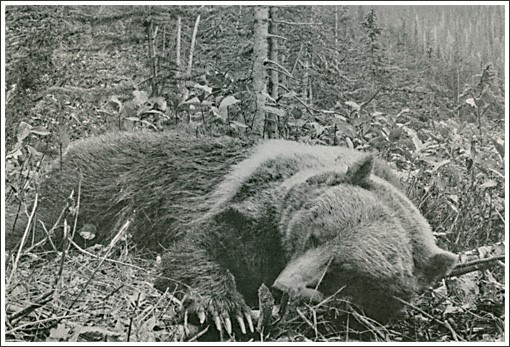In the United States, outside the Yellowstone Park and the Bitter Root Mountains, grizzly bears are now so very rare that it is almost impossible for a sportsman to go out and kill one, no matter where he hunts, and no matter how much money he spends. One of our best known writers on hunting matters, who has hunted in the West at frequent intervals during the past fifteen years, recently announced that he has now given up all hope of killing a grizzly in our own country, and has turned to British Columbia.
In British Columbia you can find grizzlies, provided you know when to go, and with whom to go. But the autumn is not the best season for finding bears in that country. If you would see the wild and untamed silver-tip, in the high altitudes, go in the spring, for that is the real season for hunting this grand species. Even then, you may hunt, as did Mr. Phillips’s brother Robert, “for forty days, straight,” without a sight of a silver-tip, or a shot; but if you are lucky, you may bag two in a month.
In the course of our camp-fire talk about bears and other animals, we had a symposium on the habits of the grizzly at the various seasons of the year. To this all the old grizzly hunters—Charlie Smith, Mr. Phillips, and the two Norboes,—contributed; and I pieced together their individual statements, and made up this:
GRIZZLY BEAR’S CALENDAR
January—About January 20th the cubs are born, in the winter den. Usually they are two in number, crudely formed, and almost hairless. They are about ten inches long, weigh about eighteen ounces, and are blind, and extremely helpless. The mother coils herself around them, moves not for many days, and the helpless little creatures are almost as much enfolded as if they were in an abdominal pouch. In the New York Zoological Park the period of gestation of the Colorado grizzly is two hundred and sixty-six days, or from April 22d to January 13th.
May—In British Columbia a few grizzlies come out as early as May 1, but the majority appear about the 20th. Their first spring food is the roots of the snowlily, which is found growing on the snow slides. Besides this the grizzly eats other plants, of a dozen or more species, and also grass that is young and tender. As soon as they emerge from their winter den they begin to rub their backs against trees, to scratch themselves, and they keep it up until the old hair is all off. Shedding begins early in June, and lasts until August 1.
June and July—During these months the bears range far and wide, the cubs following at the heels of the mother, searching for edible grubs and roots. In their search for edible insects, they overturn stones and tear old logs to pieces. Under every third stone (in suitable situations), a nest of ants is found; and these are greatly relished. To a bear, those sour and acidulous insects are much the same as pickles are to the human palate. The grizzly hunts up and devours all animals killed by snowslides. Mr. Phillips once knew a dead pack-rat to be eaten. In the Bush River country, Charlie Smith saw the remains of a grizzly that had been killed by a snow slide, and afterward had been dug out and eaten by another grizzly! By the end of July the shedding of the old coat of hair is completed, and the silver-tip stands forth clad in a glossy new suit of dark brown, several shades darker than the old coat. It is very short, however, even in comparison with the September coat.
August—In the valleys of the large rivers, berries begin to ripen, and the bears at once begin to feed upon them. Naturally the berries of the lowest and warmest valleys are the first to mature; and as the season advances, the boundary-line of the ripening fruit extends higher and higher up the mountains. In the highest valleys and mountains the berries do not ripen until September, just before the first heavy fall of snow. Strawberries come first, but they are so thinly scattered the total amount of food they furnish is small. Next comes the saskatoon, or service-berry, which is an important item of food, and whenever ripe is much sought by bears. They last so late into September that they detain the bears in the valleys of the large rivers when otherwise the animals would go up into the mountains to feed on huckleberries, and be shot.
September—It is in this month that the bears take on the greatest amount of fat, for winter use. By September 15 the pelage is quite long, faultless in texture, and very richly colored. Of the five species of huckleberries and blueberries that grow in the mountains, two are large and fine, and furnish an excellent supply of bear food. This is the month of bear migration, from the lower valleys upward, feeding on berries all the way. The earlier the coming of the first heavy snowfall, the earlier the migration. When the bears cannot get huckleberries, they eat black currants, but not with great relish, because they are rather bitter. The root of a “wild-pea vine” (Hedysarum) is eaten with great relish. It tastes precisely like green-pea pods, and is really very palatable. When the root is chewed, its residuum is tough and woody, but the outside is gelatinous, like slippery-elm bark.
October—After the berries are gone, the grizzlies dig for “gophers” (Citellus columbianus), and for Hedysarum roots, until the ground freezes to such a depth that they cannot break through it. When digging becomes impossible, the bears seek their winter dens, and hibernate. At most seasons of the year the male grizzly bear is a solitary creature. As a rule, the only individuals found living together are the mother and cubs. Occasionally it happens that the yearling cubs remain with their mother for some months after the birth of their successors, but the eighteen-months-old cub usually is found quite alone.
It often happens, however, that in the height of the berry season, six or seven bears may be found together in the same berry-patch; but this does not mean that all those individuals had been living together. Mr. W.H. Wright, a very successful bear-hunter, once killed seven bears in one day; and Prof. L.L. Dyche once saw on the head of the Pecos River, in New Mexico, seven grizzlies travelling together. But such occurrences are very rare exceptions, and the rule is exactly the reverse. Mr. Phillips once found two sets of tracks showing how one bear had chased another out of his territory.
Mr. Phillips’ Grizzly
Like the wolves of the Northwest, the grizzly bears of to-day know well that a deadly rifle is the natural corollary to a man. Nine grizzlies out of every ten will run the moment a man is discovered, no matter what the distance may be from bear to man. The tenth will charge you, fearlessly, especially if you make your attack from below. It is said that a wounded grizzly always runs down hill; and this may account for some charges toward hunters below, which might not have taken place had the hunter been off to one side.
It must be borne in mind that the grizzly feeds according to the bill of fare available in his locality at a given time. In some localities he feeds upon salmon, the bulbs of various plants, and even upon grass; but wherever found, he is fond of berries.
He is not a proud feeder. He turns up his nose at nothing that he can chew and assimilate, except skunks and porcupines. According to the needs of the hour, he feeds upon the best or the worst. Beyond doubt, he prefers an elk, fat, fresh and filling; but when hunger plucks vulture-like at his vitals, he will not disdain to pick a dead and bloated pack-rat out of a snow slide and put it where he thinks it will do the most good.
The carrion state does not bother him in the least, if he is hungry. Most impartially he cleans up the carcasses of big game left by the hunter. He has been known to eat the flesh of his own kind, which surely is in very bad taste, ethically, but otherwise it is not so bad in him as in the hunters who sometimes devour his hams, regardless of their origin.
Occasionally a grizzly will feed on a carcass in the daytime, but the majority wisely defer their visits until nightfall, and retire before dawn. Many a hunter has tried to kill a grizzly over the remains of a horse specially slaughtered as a bait, but none of my bear-hunting friends ever have succeeded in killing a grizzly by that plan. Usually the bear comes only in the darkness, or else remains away altogether.
I believe that nearly every time the weight of a grizzly bear is estimated, it is greatly over-estimated. The size of a stretched skin, and the length of the pelage in the winter season, always suggests an animal larger and heavier than the reality. Trim down every “estimate” fully one-third, and you will have something near the proper figure. In bear-guessing errors, the writer is no exception. Bears always have seemed to me much larger than the cold and unimaginative scales show them to be.

You’ll be pleasantly surprised by the high-quality photographs and drawings from decades long gone that are scattered throughout these titles. This series includes books by renowned adventure authors such as Theodore Roosevelt, William T. Hornaday, Charles Sheldon, and Frederick C. Selous, to mention only a few. Available online at:
www.historyofhunting.com/camp-fires-in-the-canadian-rockies
www.boone-crockett.org


